

Back on the 'Dyno'
Tuesday’s column about Don Nicholson bought out the love for the dyno man and a slew of those whose lives he touched. I’ll share some of those stories below as well as offer great additions to the Psycho Mustang tale I also wrote about earlier this week, then catch up on some topics from last Friday. Lots of ground to cover, so off we go …
First things first. I heard from Frank Oglesby, who took mild exception to John Jodauga’s seemingly innocuous comment about Oglesby's time behind the wheel of Nicholson’s Eliminator Cougar not resulting in “the same level of success” that “Dyno” enjoyed.
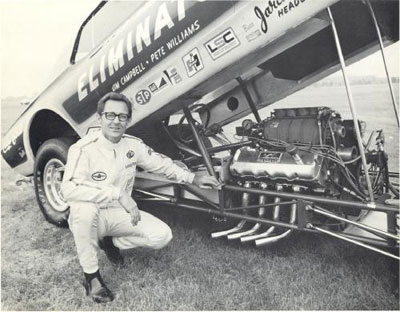 |
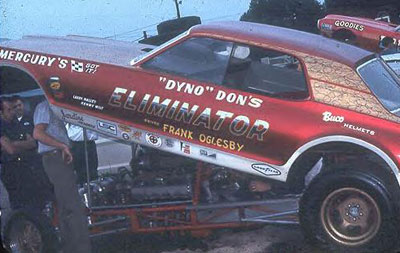 |
Oglesby was the crew chief for Nicholson when he won the S/XS class in Indy in 1967 -- their reward for a class win? A Craftsman tackle box, fender covers, and a $100 government bond – and took runner-up honors behind Paul Stage for the overall Super Eliminator victory. According to Oglesby, he ended up working for Nicholson after he and Jay Howell had built a supercharged machine for Bill Taylor that beat Nicholson’s injected Comet “like a redheaded stepchild” three or four times in a row. Deciding that he’d rather switch than fight, Nicholson hired Oglesby, who already had experience driving nitro cars and took the job with the proviso that he would get to drive in the future.
Recalled Oglesby, “He told me, ‘I don’t know how long I can do this, but I’ve got plenty of dates, so if you come and make this happen and not kill me, you can drive,' but it kept getting put off and put off. When Don finally decided he didn’t want to drive the Funny Car anymore halfway through 1968 – he wanted to drive a carbureted or injected car again – he still had a bunch of race dates for that year and the next to fulfill. We ran on the Mercury money for the rest of the year, but for 1969, he said, ‘How about we just put you on a percentage?' I ran the car on 50 percent of what the tracks were paying. All of the other money that came in was his -- as rightfully it should have been – but the money I had to run that car was not nearly enough. Obviously, we’re not going to win Indy anymore. Nothing against ‘Dyno’; that’s just the way it was. I hate to be complaining about this 40 years later, but my friends were bugging me to tell my side, so there you have it.”
So, once again, your prototypical DRAGSTER Insider story behind the story -- isn’t there always one? -- and I really love Nicholson's "and not kill me" disclaimer.
Bill Ross also can claim early bragging rights; he first met Nicholson in 1958 when Nicholson was the engine man and tuner for the Gireth Bros./Horsepower Specialties B/Fuel Dragster. “Don, Bud, and Chuck Gireth opened a shop in Monrovia [Calif.] called Horsepower Specialties," remembered Ross. "This is where Don had a dyno and tuned my '55 Chevy. I would go on road trips with them as a gofer. Don was always great, never talked down to me. I was 17 at the time. One of our road trips was to Bakersfield, Aug 3, 1958. This was when Bill Crossley was the first on the West Coast to go over 170 mph at this meet. Don had that small-block Chevy running great that day. We beat the Top Banana to take B/Fuel, then went on to beat Emory Cook for Top Eliminator. Chuck was quicker off the line than anybody there that day. One of the best quotes I ever heard was when we got to the end of the strip after beating the Top Banana, and Chuck said, ‘Anybody want a banana? I just peeled one.’ Don had done a lot of racing long before he went to work at Service Chevy in Pasadena. I went to his memorial service at the NHRA Museum, but nobody talked about what he did prior to 1962.”
Mike Howell was a close second. “After my discharge from the Navy in 1961, I bought a ’61 Corvette with the 283 fuel motor, close-ratio four-speed, and 4:56 positraction axle from Service Chevrolet,” he remembered. “Don Nicholson dyno-tuned it for me, and I raced it as a hobby at several strips, including Fontana, San Fernando, and Lions. It ran in the 12s, and I had some success. I’m 72 now and remember those days often.”
 |
Regarding Nicholson’s Atlanta connection, I heard from Gary Johnson, son of the late longtime official NHRA Division 2 photographer Marty Johnson. “My father had a long relationship with ‘Dyno,’ who actually had a house in the North Druid Hills area of Atlanta for several years," he wrote. "I understood from my father that [Nicholson] lived on the East Coast during match race season and went back to the West Coast in the winter.”
Marty was still the Division 2 photographer when I joined NHRA early in the 1980s but passed away a few years ago. Gary sent this great photo of his dad photographing Nicholson and crew, though the subject of the photo is clearly the photographer and his young son. “I sure miss talking racing -- or ‘bench racing’ as he would call it – with him,” he lamented. “I went to the Dallas race a few weeks ago and had the pleasure of meeting Raymond Beadle; unfortunately, all of the people that would have gotten a kick out of that have passed also.”
Canadian reader Jim Millard had a Nicholson question for which I couldn’t find an answer, but maybe one of the sharp minds out there in the Insider Nation can. “Wasn't it ‘Dyno Don's’ Pro Stock Maverick body that was acid-dipped a little longer than what was deemed necessary? The story, as I recall it, had whoever was dipping the body pulling it out of the vat and basically lifting out the roof and partial A and C pillars. That's all that was left of the body! Can you or any of the readership verify this?”
For the uninitiated, acid-dipping was a popular practice in the late 1960s and early 1970s before the influx of fiberglass and carbon-fiber parts. It’s a simple as it sounds: Lower your metal body parts into large vats of acid and let it eat away at the metal until they are substantially lightened. The trick, of course, is to not overdo it.
I found an article in the May 1972 issue of Car Craft about Nicholson’s Pinto that followed his two-year stint in Mavericks. The article reported that Nicholson sent his Pinto body-in-white and three doors (sides plus hatchback) to Aerochem in Orange, Calif., where the acid bath removed about 80 pounds of weight. The lightened-but-flimsy metal then was strengthened from the inside by the addition of lightweight polyurethane panels.
I asked around to several early Pro Stock experts I know but came up empty. My best bet was class historian Rick Voegelin, who replied, “Sorry, can't confirm that. Back in the day, urban legend was that one of the Mopars had spent too much time in the tank and came out missing significant parts. Acid Dipping Urban Legend No. 2 is that Roger Penske's '69 Sunoco Camaro was left in too long, roof became a trifle thin, and hence the black vinyl top on Mark Donohue's championship-winning Trans-Am Camaro."
Voegelin, also the genius behind the creation of NHRA’s original Super Modified class in which he fielded a very fast Camaro (which he still has) with Norm Mayerson, added cheekily, “I also can neither confirm or deny that any Super Modified Camaro body panels and subframe went for chemical cleaning at Aerochem -- twice.”
So, back to the original question … anyone out there know if the Maverick tale is true?

On Tuesday, I shared my story about a neighborhood encounter with the Psycho Mustang fuel altered/Funny Car hybrid, hoping to find out how it ended up living next door to me in Culver City, Calif. That part of the mystery remains intact, but I was able to get a lot of other info about the car.
Bill Duke, a sergeant with our own LAPD, had lots of firsthand info about the car because original pilot Pat Mahnken lived in his neighborhood.
“Mahnken lived a block away from me at the time,” he recalled. “Initially, the car was a tangerine-hued, Topolino-shelled creation. Initially, a blown gas 427 Ford wedge was used, and the car earned the title of either UDRA or AHRA gas altered point champion for 1965. I can’t recall the sanctioning body, but I know the award was bestowed upon them at Lions. Though gas-powered, the team qualified for the newly formed four- and eight-car AA/FA shows that were beginning to surface. The Fiat even won a AA/FA event, edging out ‘Wild Willie’ [Borsch]. I recall Mahnken's jubilation that Sunday. The car's last venture as a classic altered was very early 1966; shortly before, during, and maybe after a week or two of the AHRA Winternationals that were held that year at Irwindale. I recall seeing the car parked in front of the Mahnken residence with its new Kellison Mustang shell sans lettering.
“From there on, it was a regular staple of the weekly eight- and 16-car shows that proliferated the SoCal area. The car was even chosen to serve as part of the Ford Team at the ‘68 U.S. Manufacturers Championships. However, the car's biggest win was that which was earned by it clinching the 1967 Hot Rod Magazine meet in Super Eliminator. For years, I had the HR article that was done on the car because of its very performance that afternoon.
“While I can’t offer a historical accounting of the car's adoption of SOHC heads, I can safely make claim that it was the original altered hybrid that left these shores and went way south to Australia sans the SOHC motor. I have seen a few pics on the HAMB of the altered version, then replete with 392, being displayed at an Aussie car show. The maiden voyage found the chute to fail, resulting in it crashing in the shutoff area.
“The Gas Ronda version was dubbed Psycho II. However, it ceased running as a AA/FC by the end of 1969. Too long in the tooth. Mahnken then ran a SS/Stock Mustang for a while in 1970. I can’t recall if it was his old employer, Tim Sherlock (or Fougler, maybe Galpin) that served as a sponsor. Anyway, in 1971, the ex-Ronda Funny Car returned with 427 Ford wedge and twin carbs. Now here is where things have a human-interest story.
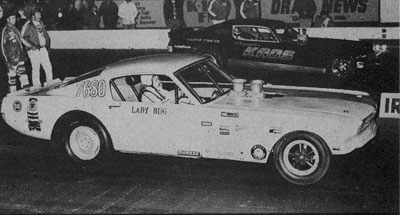 |
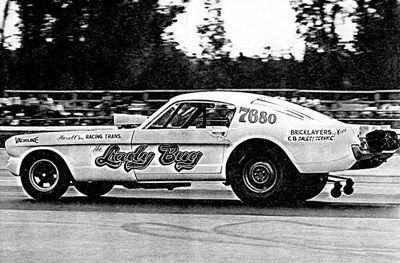 |
 |
“Mahnken found the ideal combo that allowed that Mustang to run easy mid-10s with atomic-clock consistency. I think he was winning three weeks out of four. This was when the Bracket I payout was maybe 80 or 90 bucks, a fortunate state of affairs for Mahnken as he had been the victim of a then major recession, and his position with the former car dealership had been eliminated, and he was literally able to support his family off the winnings earned week in and week out at Irwindale.
“The car remained in that guise for years. The last I saw it was maybe 1976 or so when his (don't quote me here) ex-wife got it and was racing the short-lived Econo Funny Car circuit. Nothing had changed except that the car was no longer dubbed Psycho but had been coined as the Lady Bug."
Dennis Doubleday confirmed the final part of Duke’s narrative, supplying photographic proof of the car’s life after Psycho, listing Betty Ryan as the driver. I remember seeing this car run many times at Irwindale and OCIR and never could have dreamed that this may have been the same car that lived across the alley from me as a teenager.
Kim Fuller recognized the photo of the Psycho Mustang on the trailer as having been taken on Motor Avenue, just west of the Irwindale racetrack. “As a kid, I used to ride my Schwinn down there almost daily," he reminisced. "I can’t remember exactly who it was, but they used to let me in the shop to look around. It was one of my almost-daily stops, along with riding to the turnoff roads at Irwindale and stopping by M&S Welding to see what Sherm [Gunn] was doing."
I’ve asked Fuller (and he’s agreed) to expand his little tale here to talk in detail about his introduction to the sport via proximity to cool cars as part of a collection I asked for earlier this week. I’ve already received about a half-dozen great stories of how so many young kids were introduced to the sport by nosily sticking their noses in garage doors where cool things were happening, and I want yours, too!

Lastly, here’s more feedback from the Fan Fotos collection I showed off, which included a photo of the Burkholder Bros. altered and led to Henry Walther’s humorous story about hitting a rabbit (well, humorous except to the bunny, I guess. And PETA. And the ASPCA.) at the top end while racing Harry Burkholder.
Walther shared a link to the story with Burkholder (upon whom Walther had hung the nickname “Hairy” while authoring the Nor-Cal Scene column for Drag News back in the day), and I was pleased to hear from “Hairy” himself.
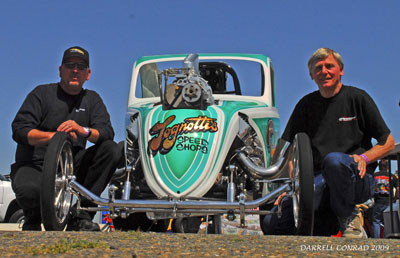 |
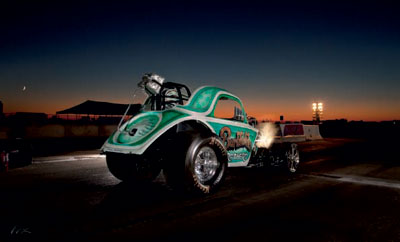 |
“Henry takes great delight when the picture of him ‘out on me’ at Sacramento Raceway shows up online,” he wrote. “I try to explain that it was taken during a burnout, and he just didn't light them up; truth is he won that one. Don't know if many people knew that Henry was a fantastic lettering artist. He did the beautiful work on the '23-T tub roadster and later the Fiat coupe. My younger cousin, Robert Reel, and I have the restored Fiat back. The car was restored by Jack Bielinski from Kent, Wash. Jack and friends up north did an incredible job on the restoration. "The King" Jerry Ruth, helped Jack find all of the 392 Chrysler parts. The car was restored in the memory of Pete Burkholder, who passed away in 1999. Cousin Robert was about 10 years old when we were running "down South," and we would pick him up and take him to all of the fuel altered shows. When the CHRR started, Robert called me, saying, ‘You need to get down here; all of your old racing buddies are here.' He then started taking me to reunion events. We have been having a blast cackling the Fiat, and I am amazed at the folks that stop by and say how much they enjoyed the altereds back in the ‘70s. We have met so many great nostalgia people, and it feels just like it was back in the day. Here are two shots of the restored Fiat, a frontal shot with Robert left and me right. My son, Jeff, took the night shot at the Kingdon Drag Strip’s 50th reunion. Kingdon was the first strip the Burkholders ran on in 1959, when I was 18 years old.”
I thanked Henry for the forward and admitted my disappointment over not hearing a slew of stories about wayward animals on the track. He replied with one: “Over the years, I have heard of others who had unexpected run-ins with critters on the dragstrip, but it wasn't until Chase Knight of Crane Cams saw your story and called me that I heard the one that takes the cake. Chase told me of a fellow Floridian who had a similar experience in Orlando with his Logghe front-engine dragster. This guy hit a skunk. God, can you imagine the consequences of that? Knowing how thorough the remains of the rabbit made its way into my car and onto me, my only question was how deep did he have to bury the car?”
Got wild animals at the drags stories? Share!

The pre-Super Chief Imperial Kustoms Charger (L&M Photo)
|
Ralph Jackson had an interesting story to share about Nelson Carter’s Super Chief Funny Car that also was part of the Fan Fotos segment. Jackson worked for Steve Bovan from 1966 to late 1969 on his red, white, and blue Camaro. “Keith Black called Steve one day asking him to test-drive the Imperial Kustoms Funny Car [as it was then known]; the driver they had owned Imperial Kustoms paint and body shop in Oklahoma and just was not a driver but was personal friends with Carter. We met Keith, Holly Hedrick,and Carter at Irwindale, and Steve made two passes. After the second pass, Keith, Steve, and Nelson had a closed meeting, and on our return to Blair's that afternoon, Steve told me they wanted him to drive the Charger. The change to Super Chief came about as a contest at OCIR for fans to pick a name for the Charger, and being as Carter was an Osage Indian from Enid Okla., two people (as I remember) came up with Super Chief.”

And finally, from prolific Insider contributor "Chicago Jon” Hoffman comes this reference to another image from the Fan Fotos segment.
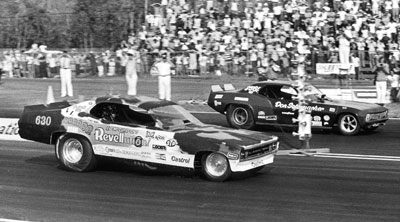
The battle-scarred floppers of Don Schumacher, far lane, and Ed McCulloch got it on in the "ugly" final at the 1972 Summernationals; Schumacher won.
|
“The one in particular that shouted out to me is the primered shot of the Chi-Town Hustler,” he wrote, “but not from the obvious hometown-hero aspect that one might expect from this lad born in the second city, but from a Phil Burgess/Reese’s Peanut Butter Cups angle (this is where Phil goes, 'Jon, jou got some 'splainin to do ...'); well …
“We all remember the commercial; the one guy’s walkin’ down the street, eating a chocolate bar (makes sense), another guy is walking down the street grazing on a jar of Skippy (which, when you think about it, is kinda creepy); they collide, two good ideas become one GREAT idea. Which brings us back to the Insider. I always loved how back in the day, the racers would have to slap their cars back together and get back out there for those lucrative dates, be they national events or a Wednesday-night match race, and -- no offense to the great paint jobs of the day -- I would always migrate over to someone whose car was in primer or whatever. In 1972, in what was billed as the 'ugliest final EVER,' Don ‘the Shoe’ [Schumacher] and Ed ‘the Ace’ [McCulloch] squared off in Englishtown, and a few weeks later repeated the feat at Ron Leek’s Byron Dragway, so, how about a – drum roll, please -- Fan-Fotos-of-primered-cars theme?
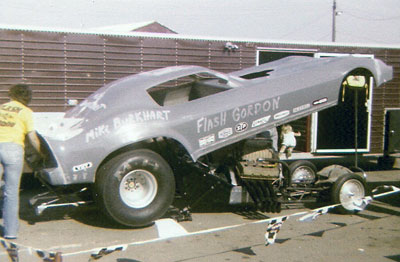 |
“We already touched on the subject, via the iconic-enough-to-be-made-a-Hot-Wheels Prudhomme car, but I know that there’s a jillion ‘stories in the naked city’ of cars rushed back out into action, so I bet that, much like Kevin Costner in Field of Dreams, if you build it, they will come. I've enclosed, from a 1979 NHRA points race at Great Lakes Dragaway, the late great ‘Flash Gordon’ Mineo in an apparently short-lived collaboration with Mike Burkhart. You gotta LOVE a car with the name written on it with shoe polish. Hey, go down to the local something-mart and ask the kid in the smock for shoe polish; watch the ‘Huh?’ expression on his face. Last month, I asked for carbon paper -- same thing … priceless.”
OK, so there’s the grist for another future column. I’ll keep my eyes peeled for more primered hot rods and expect a torrent from readers. Could be interesting, if not pretty. In fact, this could get downright ugly, which is pretty much how we roll here at the Insider anyway. Keep on writing.



















































